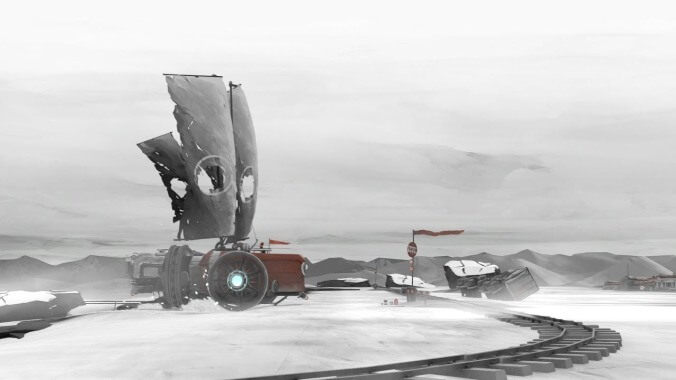Rolling through a more artful post-apocalypse in Far: Lone Sails

Every Friday, A.V. Club staffers kick off our weekly open thread for the discussion of gaming plans and recent gaming glories, but of course, the real action is down in the comments, where we invite you to answer our eternal question: What Are You Playing This Weekend?
Far: Lone Sails
For all its superlative greatness, God Of War sucked at boat-riding. Hitting the open seas felt good and looked great, but the second you hopped in the boat, the game spooled up another “lore podcast” for you to listen to, shattering what could’ve been a lovely idyll amid all the monster-slaying. I’ve come to love these moments in games—the horseback reveries of Breath Of The Wild, the meditative solitude of Truck Simulator, the taut little paths you cut with your sparrow in Destiny. No game should just be driving like this, but a lot of driving? A lot of driving is nice.
Far: Lone Sails gets this. The side-scrolling journey’s best moments are the long stretches spent rolling rightward through a color-drained, post-apocalyptic landscape. Its barren fields and gloomy megastructures recall the work of Playdead games, whose medium-defining landscapes told tales of incomparable richness. The small team behind Far doesn’t quite scrape those heights, but it gets closer than almost anyone has since, creating post-industrial wastelands full of eerie beauty, refuse, heartbreak, and narrative detail—an upturned oil tanker here, a lonely baby carriage there.
You’re not just rolling forward but rather hopping around inside your ramshackle steampunk tractor, pushing pleasingly tactile buttons to keep your hissing, malfunctioning dirigible rolling. (It can feel just as exuberant here as it did in Lovers In A Dangerous Spacetime.) Your ship’s eventual upgrades provide subtle mechanical complications, but moving through the wasteland is never challenging, instead letting you settle into a more meditative state as the ruined world rolls by. I can already see people complaining about the game’s repetition, but it’s no more repetitive than the average platformer, and significantly more beautiful, juggling brainy ideas about energy consumption and the filmic potential of games effortlessly and wordlessly. Beneath it all is something human and primal: the desire to carry on, despite unthinkable odds. The desire to keep rolling rightward, to see what lies just beyond the limits of the screen. Few games take that desire as seriously as Far. [Clayton Purdom]
Pillars Of Eternity II: Deadfire
I never experienced the golden age of computer RPGs. Even as it reached its zenith at the turn of the millennium, I was way too young to understand anything as mechanically dense as Baldur’s Gate II or as narratively rich as Planescape: Torment. I was still playing around in the console kiddie pool, burying my head in Nintendo Power, not Computer Gaming World. As I got older and deeper into this hobby, I got more and more curious about the games in those blindspot, but every attempt I made at trying to go back to these beloved games ended in bouncing off them after an hour or two (if that). I’ve had the same problem with all the new games in the recent wave of CRPG revivalists, but I’m an idiot and keep buying them, thinking at some point I’ll find one that sticks.
Well, I think I’ve finally found that one. I jumped into Obsidian’s Pillars Of Eternity II on a whim—after pulling the same 90-minutes-and-done crap with the first one—and I’m fully hooked. I could see it being a sticking point for players who get into this sort of thing more for the dangerous Dungeons & Dragons-inspired battles, but what’s really doing it for me here is the writing. It’s always vivid and lively, whether describing a cosmic conversation with towering gods or a fuzzy cat pirate’s romantic history. And that prose is given tons of room to blossom as the game frequently depicts scenes that don’t strictly involve fighting or talking through text-adventure-like breaks in the action. When you are maneuvering through conversations, the various dialogue options you’re given run a nice gamut from curt to playful to steadfastly virtuous, the tone you choose being tracked as you go, encouraging you to actually, you know, play a role (especially if you’re playing a paladin, like me, and get various bonuses by sticking to the principles of your chosen order).
As is usually the problem, I still have trouble with the combat. It can be brutally unforgiving to a newbie like me, and as much as I really do want to finally wrap my head around it, I think I’m content to throw the game into the easiest difficulty so I can get back to the stuff I’m really here for: all those wonderful, flowery words. Thank god for developers finally wising up and including these “tell me a story” settings. [Matt Gerardi]